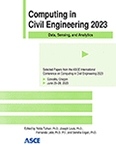Self-Optimization of Robot Design for Navigating in Ceiling Systems
Publication: Computing in Civil Engineering 2023
ABSTRACT
Suspended ceiling systems are complex and heterogeneous due to the combination of different components. Therefore, it is hard for robots to navigate in these environments without expert designed robot morphology. However, the cost of robot design is high since ceiling systems vary from building to building. Currently, some studies demonstrate that robots can evolve like creatures so that they can adapt themselves to different environments through evolutionary strategies. Inspired by the assembly of LEGO bricks, we applied graph grammar methods to optimize robot design in suspended ceiling systems. The basic idea is that the robot can find the optimized structures assembled from elementary components for themselves without any human intervention. Robots were trained in four common ceiling environments reflecting the influence of typical terrain and obstructions (e.g., ducts). Results show that different suspended ceiling system significantly affects the configuration of robots and robots can successfully evolve specific shapes to improve their acclimatization. This paper marks the first attempt at performing robot evolution in the context of facilities management and is expected to evoke future discussions in robot design in more civil engineering tasks.
Get full access to this article
View all available purchase options and get full access to this chapter.
REFERENCES
Beer, R., Chiel, H., and Sterling, L. S. (1989). “Heterogeneous neural networks for adaptive behavior in dynamic environments.” Proc. Adv. Neural. Inf Process. Syst., San Francisco, CA, 577–585.
Blad, C., Bøgh, S., and Kallesøe, C. S. (2022). “Data-driven Offline Reinforcement Learning for HVAC-systems.” Energy, 261, 125290.
Borik, A., Kallangodan, A., Farhat, W., Abougharib, A., Jaradat, M. A., Mukhopadhyay, S., and Abdel-Hafez, M. (2019). “Caged Quadrotor Drone for Inspection of Central HVAC Ducts.”, Advances in Science and Engineering Technology International Conferences, Dubai, 1–7.
Cai, W., Zhang, L., Huang, L., Yu, X., and Zou, Z. (2022). “TEA-bot: A Thermography Enabled Autonomous Robot for Detecting Thermal Leaks of HVAC Systems in Ceilings.” BuildSys, New York, 30–39.
Elnour, M., Meskin, N., and Al-Naemi, M. (2020). “Sensor data validation and fault diagnosis using Auto-Associative Neural Network for HVAC systems.” J. Build. Eng., 27, 100935.
Funes, P., and Pollack, J. (1998). “Evolutionary body building: Adaptive physical designs for robots.” Artif. Life, 4(4), 337–357.
Hannan, M. A., Faisal, M., Ker, P. J., Mun, L. H., Parvin, K., Mahlia, T. M. I., and Blaabjerg, F. (2018). “A Review of Internet of Energy Based Building Energy Management Systems: Issues and Recommendations.” IEEE Access, 6, 38997–39014.
Kong, M., Dong, B., Zhang, R., and O’Neill, Z. (2022). “HVAC energy savings, thermal comfort and air quality for occupant-centric control through a side-by-side experimental study.” Appl. Energ., 306, 117987.
Lei, X., Chen, Y., Bergés, M., and Akinci, B. (2021). “Formalized control logic fault definition with ontological reasoning for air handling units.” Automat. Constr., 129, 103781.
Rowe, A., Berges, M. E., Bhatia, G., Goldman, E., Rajkumar, R., Garrett, J. H., Moura, J. M., and Soibelman, L. (2011). “Sensor Andrew: Large-scale campus-wide sensing and actuation.” IBM J. Res. Dev., 55, 1–6.
Sadhukhan, D., et al. (2020). “Estimating surface temperature from thermal imagery of buildings for accurate thermal transmittance (U-value): A machine learning perspective.” J. Build. Eng., 32, 101637.
Salleh, M. Z. M., Rashid, N. K. A. M., and Mustafah, Y. M. (2013). “ANFIS -Based Navigation for HVAC Service Robot with Image Processing.” IOP Conf. Ser.: Mater. Sci. Eng., 53, 012087.
Schaff, C., Yunis, D., Chakrabarti, A., and Walter, M. R. (2019). “Jointly Learning to Construct and Control Agents using Deep Reinforcement Learning.” ICRA, IEEE, 9798–9805.
Stockli, F., and Shea, K. (2017). “Automated Synthesis of Passive Dynamic Brachiating Robots Using a Simulation-Driven Graph Grammar Method.” J. Mech. Design, 139(9), 092301.
Taube, J. S., Muller, R. U., and Ranck, J. B. R., Jr. (1990). “Head-direction cells recorded from the postsubiculum in freely moving rats. I. Description and quantitative analysis.” J. Neurosci., 10, 420–435.
Ying, Z., You, J., Morris, C., Ren, X., Hamilton, W., and Leskovec, J. (2018). “Hierarchical Graph Representation Learning with Differentiable Pooling.” Proc. Adv. Neural. Inf Process. Syst., Montréal, 4800–4810.
Zhao, A., Xu, J., Konaković-Luković, M., Hughes, J., Spielberg, A., Rus, D., and Matusik, W. (2020). “RoboGrammar: Graph Grammar for Terrain-Optimized Robot Design.” ACM T. Graphic., 39(6), 1–16.
Information & Authors
Information
Published In
History
Published online: Jan 25, 2024
ASCE Technical Topics:
- Architectural engineering
- Automation and robotics
- Benefit cost ratios
- Bricks
- Building design
- Building materials
- Building systems
- Business management
- Ceilings
- Chemical properties
- Chemistry
- Design (by type)
- Engineering fundamentals
- Engineering materials (by type)
- Environmental engineering
- Financial management
- Heterogeneity
- Materials engineering
- Models (by type)
- Optimization models
- Practice and Profession
- Structural engineering
- Structural systems
- Systems engineering
Authors
Metrics & Citations
Metrics
Citations
Download citation
If you have the appropriate software installed, you can download article citation data to the citation manager of your choice. Simply select your manager software from the list below and click Download.
